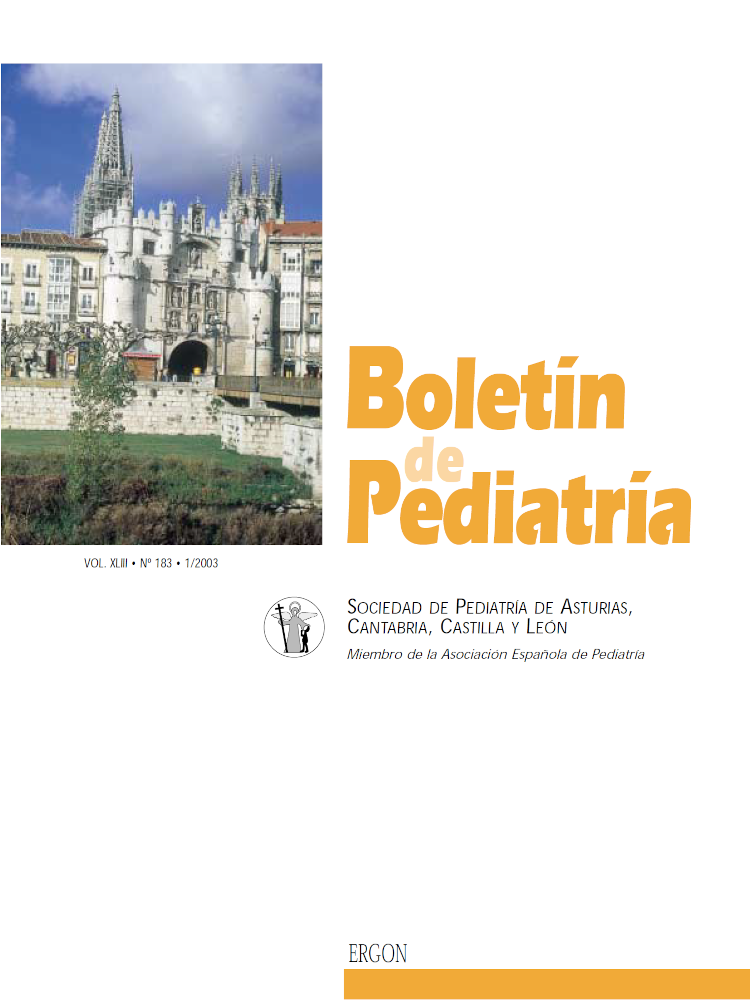Abstract
Introduction:West syndrome (WS) is characterized by spasms in clusters, hypsarrhythmia and developmental stagnation or regression. The objective of this study is to know the etiologic distribution of WS in our area and changes over time.
Method: Retrospective study of 20 children with WS diagnosis from 1993 to 2001. Causes are analyzed, and diagnostic methods used, therapy, and progress are described. Results are compared with other study made from 1975 to 1986 in the same hospital.
Results: Ratio male: female of 1.5:1. The mean age of beginning of the spasms was 7.4 months, with a diagnosis delay of at least one month in 60% of the patients. 16 symptomatic cases (11 of prenatal origin, 4 perinatal and 1 postnatal), 3 cryptogenic and 1 idiopathic were identified. The hypsarrhythmia and the spasms disappeared in all patients, but half of symptomatic cases persisted with other types of seizures. 3 exitus were recognized, all of them symptomatic. The rate of symptomatic cases was significantly higher in the 1993-2001 period (16/20, 80%) than in 1975-1986 (15/30, 50%).
Conclusions: New technologies help to identify a bigger proportion of patients with SW as symptomatic. It still exists an important delay in the diagnosis, because of the confusion between spasms and other paroxystic non epileptic episodes. In presence of a clinic suspicion, an EEG must be done for discarding or confirming hypsarrhythmia. The pre-existing lesions condition the bad progress of symptomatic WS.
References
Dulac O. What is West syndrome? Brain Dev 2001; 23: 447-52. 2. https://doi.org/10.1016/S0387-7604(01)00268-6
West WJ. On a peculiar form of infantile convulsions. Lancet 1841;1: 724-5. https://doi.org/10.1016/S0140-6736(00)40184-4
Gibbs FA, Gibbs EL. Atlas of electroencephalography, Epilepsy, vol II. Cambridge (EE.UU.): Addison-Wesley; 1952.
Watanabe K, Negoro T, Okumura A. Symptomatology of infantile spasms. Brain Dev 2001; 23: 453-66. https://doi.org/10.1016/S0387-7604(01)00274-1
Wong M, Trevathan E. Infantile spasms. Pediatr Neurol 2001; 24: 89-98. https://doi.org/10.1016/S0887-8994(00)00238-1
Commission on Classification and Terminology of the International League Against Epilepsy. Proposal for revised classification of epilepsies and epileptic syndromes. Epilepsia 1989; 30: 389-99. https://doi.org/10.1111/j.1528-1157.1989.tb05316.x
Commission on Pediatric Epilepsy of the International League Against Epilepsy. Workshop on infantile spasms. Epilepsia 1992; 33: 195. https://doi.org/10.1111/j.1528-1157.1992.tb02306.x
Solís G, García Merino A, Fernández Pérez M, de Juan J, Valdés-Hevia J, Crespo M. Síndrome de West: epidemiología y clínica de 30 casos. Bol Pediatr 1988; 127: 45-51.
Solís G, García Merino A, Fernández Pérez M, de Juan J, Valdés-Hevia J, Crespo M. Pronóstico a largo plazo del Síndrome de West: a propósito de una casuística. Bol Pediatr 1988; 128: 159-65.
Antoniuk SA, Bruck I, Spessatto A, Halick SM, de Bruyn LR, Meister E et al. Síndrome de West: evolução clínica e electrencefalogáfica de 70 pacientes e desposta ao tratamento com hormônio adrenocorticotrófico, prednisona, vigabatrina, nitrazepam e ácido valproico. Arq Neuropsiquiatr 2000; 58: 683-90. https://doi.org/10.1590/S0004-282X2000000400014
Cowan LD, Hudson LS. The epidemiology and natural history of infantile spasms. J Child Neurol 1991; 6: 355-64. https://doi.org/10.1177/088307389100600412
Appleton RE. West syndrome: long-term prognosis and social aspects. Brain Dev 2001; 23: 688-91. https://doi.org/10.1016/S0387-7604(01)00264-9
Chugani HT, Conti JR. Etiologic classification of infantile spasms in 140 cases: role of positron emission tomography. J Child Neurol 1996; 11: 44-8. https://doi.org/10.1177/088307389601100111
Hancock E, Osborne JP, Milner P. The treatment of West syndrome: a Cochrane review of the literature to December 2000. Brain Dev 2001; 23: 624-34. https://doi.org/10.1016/S0387-7604(01)00299-6

This work is licensed under a Creative Commons Attribution-NonCommercial 4.0 International License.
Copyright (c) 2003 Boletín de Pediatría
